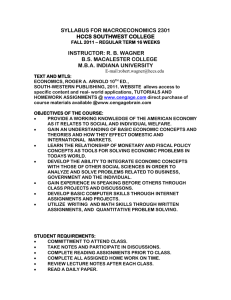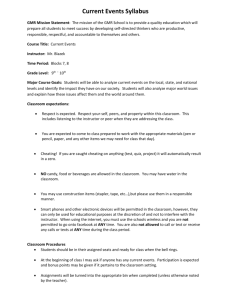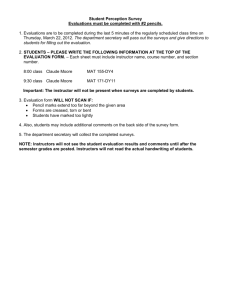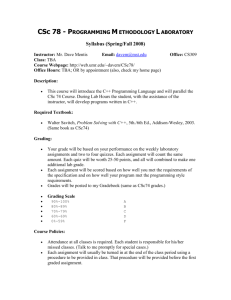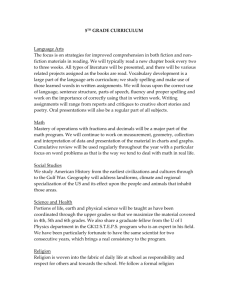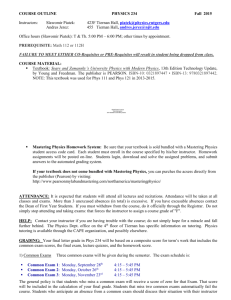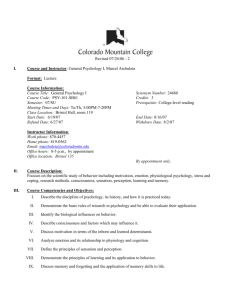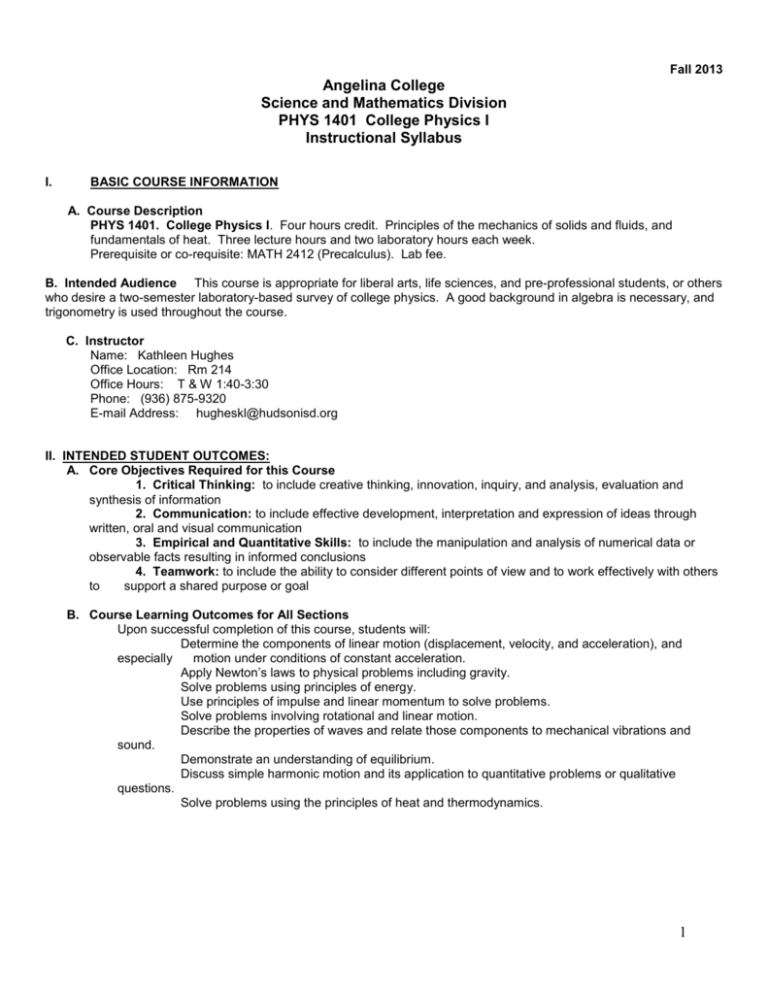
Fall 2013
Angelina College
Science and Mathematics Division
PHYS 1401 College Physics I
Instructional Syllabus
I.
BASIC COURSE INFORMATION
A. Course Description
PHYS 1401. College Physics I. Four hours credit. Principles of the mechanics of solids and fluids, and
fundamentals of heat. Three lecture hours and two laboratory hours each week.
Prerequisite or co-requisite: MATH 2412 (Precalculus). Lab fee.
B. Intended Audience This course is appropriate for liberal arts, life sciences, and pre-professional students, or others
who desire a two-semester laboratory-based survey of college physics. A good background in algebra is necessary, and
trigonometry is used throughout the course.
C. Instructor
Name: Kathleen Hughes
Office Location: Rm 214
Office Hours: T & W 1:40-3:30
Phone: (936) 875-9320
E-mail Address: hugheskl@hudsonisd.org
II. INTENDED STUDENT OUTCOMES:
A. Core Objectives Required for this Course
1. Critical Thinking: to include creative thinking, innovation, inquiry, and analysis, evaluation and
synthesis of information
2. Communication: to include effective development, interpretation and expression of ideas through
written, oral and visual communication
3. Empirical and Quantitative Skills: to include the manipulation and analysis of numerical data or
observable facts resulting in informed conclusions
4. Teamwork: to include the ability to consider different points of view and to work effectively with others
to
support a shared purpose or goal
B. Course Learning Outcomes for All Sections
Upon successful completion of this course, students will:
Determine the components of linear motion (displacement, velocity, and acceleration), and
especially
motion under conditions of constant acceleration.
Apply Newton’s laws to physical problems including gravity.
Solve problems using principles of energy.
Use principles of impulse and linear momentum to solve problems.
Solve problems involving rotational and linear motion.
Describe the properties of waves and relate those components to mechanical vibrations and
sound.
Demonstrate an understanding of equilibrium.
Discuss simple harmonic motion and its application to quantitative problems or qualitative
questions.
Solve problems using the principles of heat and thermodynamics.
1
III. ASSESSMENT MEASURES
A. Assessments for the Core Objectives:
1.
Critical Thinking:
Student responses to problem assignments and embedded test questions will be analyzed.
2.
Communication:
Free responses on lab reports will indicate students’ ability to communicate effectively.
3.
Empirical and Quantitative Skills:
Responses to both conceptual and quantitative assignments are assessed with an AC rubric.
4.
Teamwork:
Cooperative efforts in lab are summarized with an appropriate AC rubric.
B. Assessments for Course Learning Outcomes
Each of the learning outcomes is assessed through analysis of specific assignment problems and embedded test
questions throughout the course.
IV.
INSTRUCTIONAL PROCEDURES:
A.
Methodologies common to all sections
This course is taught principally by lecture, supplemented as appropriate with demonstrations, class discussions, and
daily written work.
B. Methodologies determined by the instructor
Course information, including assignments, copies of handouts, review material, and printable views of the
overheads used in class are available to all enrolled students via Blackboard on the internet.
V. COURSE REQUIREMENTS AND POLICIES:
A. Required Textbooks, Materials, and Equipment –
1. College Physics, Volume 1, 8th Edition by Young and Geller, Pearson/Addison Wesley
2. A scientific calculator (preferably graphing) is necessary to complete assignments.
There is no laboratory manual that must be purchased. Individual lab information is distributed weekly
at the beginning of labs.
Materials Required by the Instructor Problem assignments are available and submitted through Sapling Learning, an online homework resource.
Students must register through the bookstore material or online at Saplinglearning.com.
B. Course Policies – (This course conforms to the policies of Angelina College as stated in the
Angelina College Handbook.)
1. Academic Assistance –
If you have a disability (as cited in Section 504 of the Rehabilitation Act of 1973 or Title II of the Americans
with Disabilities Act of 1990) that may affect your participation in this class, you should see Karen Bowser,
Room 208F of the Student Center. At a post-secondary institution, you must self-identify as a person with a
disability; Ms. Bowser will assist you with the necessary information to do so. To report any complaints of
discrimination related to disability, you should contact Dr. Patricia McKenzie, Administration Building, Room
105 or 936-633-5201.
2. Attendance –
Attendance is required as per Angelina College Policy and will be recorded every day. Any student with three
(3) consecutive absences of four (4) cumulative absences may be dropped from the class. Records will be
turned in to the academic dean at the end of the semester. Do not assume that non-attendance in class will
always result in an instructor drop. You must officially drop a class or risk receiving an F.
Students are expected to attend and participate in weekly laboratory sessions.
2
3. Additional Policies Established by the Individual Instructor –
No eating, drinking, or smoking is allowed in any classroom, including the lab room.
Any child care problems must be handled outside the classroom.
Turn off cell phones and put away similar devices during class. Only calculators should be out.
Students are expected to exhibit civility and academic honesty (do your own work) during the
course.
If you need to leave class early, inform the instructor - otherwise it will be counted as an absence.
VI. COURSE CONTENT:
The main topics discussed in this course are:
Vector kinematics (Chapt. 1-3) and dynamics (Chapt 4,5)
Gravitation (Chapt 6)
Energy, momentum, and conservation laws (Chapt 7,8)
Rotational kinematics and basic dynamics (Chapt 9,10)
Periodic motion and waves (Chapt 11,12)
Properties of fluids (Chapt 13)
Heat, temperature, and basic thermodynamics (Chapt 14,15)
Specific dates of topics and exams are listed on the last page.
VII. EVALUATION AND GRADING:
A. Grading Criteria
Grades are determined by numerical scores on the following written components:
Assignments (20%) Homework assignments are problem solutions from the text book. Each
assignment should be completed within one week. Assignments may be turned in up to one week late for halfcredit.
Laboratory (20%) Each lab has a written report to be turned in within one week. Labs may be turned in up to
one week late for half-credit. Your two lowest (or missing) grades will be eliminated from consideration. Your
grade will be best on the best ten labs.
Tests (14% each) The material covered is given on the schedule. The lowest grade (which may
be a missed test) is replaced by your next-lower test grade.
Final Exam (18%) This is a comprehensive test, but emphasizes the most recent material.
B. Determination of Grade
Letter grades are determined from your course average based on the following guidelines (which
may
be revised when appropriate in the student's favor) :
Numeric Average
90 - 100
80 - 89
70 - 79
60 - 69
Below 60
Grade
A
B
C
D
F
A copy of your grades and current average will be distributed near mid-semester, after Test 2, and near the end, after
Test 3, to inform you of your progress and status, and to allow verification that your grades have been accurately
recorded. Individual test grades will not be curved, but the final course average may be subject to a curve at the
instructor’s discretion.
VIII. SYLLABUS MODIFICATION:
The instructor may modify the provisions of the syllabus to meet individual class needs.
3
Class Schedule
(Tentative schedule, subject to revision as necessary)
Fall 2013
Date
Topic and Reading Assignment
Sept 3
5
Introduction, Units of measurement, Conversions. (Chapter 1)
Displacement, Velocity, Acceleration. (2.1 - 2.4)
10
12
Free fall. (2.4, 6)
Vectors, Components (1.7, 8)
17
Projectile motion. (3.1-3.3)
19
24
26
Relative motion, Force, Mass (3.5, 4.1- 4.3)
Review
Test 1 (Chapters 1 - 3)
Oct 1 Newton's laws (4.4 - 4.6)
3
8
Applications, Friction (5.1 - 5.3)
Circular motion (3.4, 6.1)
10
Gravitation. (6.3 - 6.5)
15
17
Work and Energy (7.1 - 7.5)
Conservation of energy, Power. (5.4, 7.6 - 7.8)
22
24
29
Momentum, Conservation, Collisions. (8.1 - 8.4)
Center of mass (8.1 - 8.4), Review
Test 2 (Chapters 4 - 8)
31
Rotational motion (9.1 - 9.5)
[Nov 1= Last day to drop]
Nov 5
Torque, Angular momentum (10.1 - 10.4)
7
Equilibrium, Periodic motion (10.5 - 10.7, 11.2)
12
Simple harmonic motion, Pendulum (11.3 - 11.5)
14
19
Waves and Superposition. (12.1 - 12.5)
Wave Properties and Sound (12.6 - 12.9, 11, 12)
22
26
Density, Pressure in fluids, Archimedes' principle, Review. (13.1 - 13.3)
Test 3 (Chapters 9 - 13)
Dec 3
5
10
Temperature and Thermal expansion (14.1 - 14.4)
Calorimetry, Equations of state (14.5 - 14.7, 15.1 - 15.2)
Kinetic theory, First law of thermodynamics (15.3 - 15.7)
12
19
Heat engines; Review. (16.2, 16.5 - 16.7)
Comprehensive Final Exam. (8:00 a.m. - 10:00 a.m.)
4


